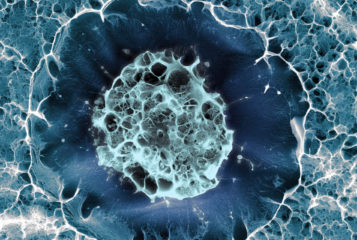French researchers have described a technique to produce human sperm cells in the laboratory as they attempt to patent the method.
Earlier this year Kallistem Laboratory in Lyon, France, claimed to have successfully produced sperm cells outside the body, using immature cells known as spermatogonia (see BioNews 802).
The researchers say the method took 20 years to refine, and it may be several years before the quality of the sperm is confirmed. The research is yet to be peer reviewed and, while the sperm cells appear normal, it is not known whether they are able to create life.
Kallistem is currently attempting to produce live rats using the 'artificial sperm' technique, Agence France Presse reports. Philippe Durand, a project member, told journalists at a press conference in Lyon: 'We must see if the baby rats are normal, and whether they are able to reproduce.'
The European patent application describes the method used by the Kallistem researchers. They recreated the fluid found in the seminiferous tubules — tiny structures in which sperm cells are formed — and used this to coax immature sperm cells into developing into normal-looking sperm.
Until now, scientists had managed to push sperm cells most of the way towards becoming mature sperm. 'We were stuck at the final stage of spermatogenesis,' Durand told the Huffington Post. 'It's the final 20 percent of the process.'
The scientists realised that the tubules were disintegrating at this final stage, so they encased them in cylinders made of chitosan — a gel that is extracted from shells of crustaceans. The sperm take 72 days to develop, after which the researchers dissolve the chitosan cylinders to extract the sperm.
Clinical trials involving human sperm cells are expected to commence in 2017, but this is dependent on the team obtaining permission to use the lab-manufactured sperm to fertilise a human egg.
Their aim is to eventually freeze tissue from pre-pubescent boys who are about to undergo cancer treatment, to see if the technique will allow them to become fathers later in life, as spermatogonia can be destroyed during chemotherapy or radiotherapy.
However, infertility researcher Professor Nathalie Rives, from the CHU Hospital in Rouen, told AFP: 'We are not there yet.'
'Before this technique can find any practical application, it must be proven to work with (cells) from the testes of prepubescent boys and men who have trouble generating sperm,' she added.
Other specialists have also said that they are holding fire before drawing conclusions about the technique.
'We're waiting impatiently for a peer-reviewed scientific publication. But until then, it is difficult to comment,' Professor Louis Bujan, from Paul Sabatier University in Toulouse, told Le Monde.
Sources and References
-
Patent for first method to create human sperm, but does it work?
-
French startup claims development of in-vitro human sperm
-
Scientists create human sperm in a lab
-
European Patent Application - EP 2 886 644 A1
-
Traitement de l'infertilit?®: des spermatozo?»des in vitro ont ?®t?® produits par la soci?®t?® lyonnaise Kallistem







Leave a Reply
You must be logged in to post a comment.